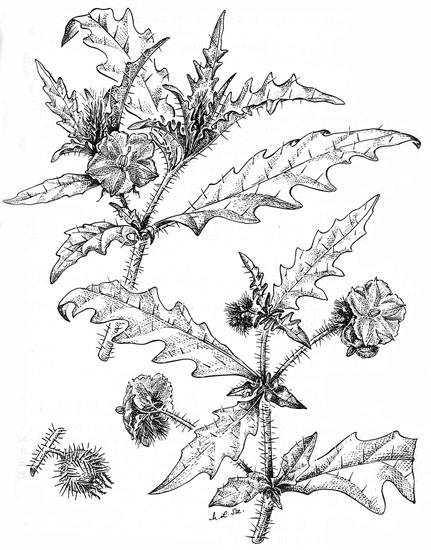
Synonymy
Solanum leopoldense Symon, Trans. Roy. Soc. S. Austral. 95: 231; fig. 6 (1971), as leopoldensis.
T: Bold Bluff, King Leopold Range, W.A., 26 May 1971, D. E. Symon 7040; holo: PERTH; iso: AD ex ADW, CANB, K, L, NT.
Description
Intricate, spreading, clonal shrub to 1m, green, usually male or female; leaves pubescent with minute stellate and minute glandular hairs; prickles 1-6 mm long, abundant on most parts.
Leaves lanceolate; 2-8 cm long, 1-3 cm wide, lobed, the lobes triangular; petiole to 5 mm long.
Male plant: inflorescence 2-3 cm long, up to 11-flowered; peduncle to 3 cm long; rachis 2-3 cm long; pedicels 5-8 mm long; calyx c. 9-11 mm long, the lobes triangular to lanceolate with linear apices, 6-7 mm long; corolla broadly stellate, 30 mm diam., pale lilac; anthers 4-5 mm long. Female plant: flowers solitary; pedicels 5-10 mm long; calyx 10-11 mm long, enlarged in fruit, the lobes linear, 5-6 mm long; corolla broadly stellate, 25-30 mm diam., purple; anthers 4-5 mm long.
Fruiting calyx 15-25 mm diam., lobes 5-10 mm long. Berry depressed-globular, 15-20 mm diam., green when ripe, drying pale brown. Seeds 1.5-2 mm long, dark brown. n=12.
Distribution and ecology
Restricted to King Leopold Range and adjacent areas in the Kimberley region of W.A.
Occurs in rocky gullies and creeklines.
Relationships
All of the dioecious members of the Dioicum group of subgen. Leptostemonum exhibit functional dioecy i.e. male flowers are borne on separate plants from what appear to be plants with bisexual or hermaphrodite flowers; while these bisexual flowers do produce pollen, it is inaperturate and does not germinate, making the flowers effectively female (Knapp et al.,1998).
Initial molecular studies by Martine et al. (2006) suggested that the two functionally dioecious species from Kakadu, S. asymmetriphyllum and the newly described S. sejunctum, formed a separate clade and had arisen separately from the other dioecious members of the Dioicum group, S. cunninghamii, S. cataphractum , S. dioicum, S. petraeum, S. carduiforme, S. tudununggae, S. vansittartense and S. leopoldense. This initial DNA analysis involved sequencing of the ITS region of nuclear rDNA.
However further molecular analysis involving the trnK-matK gene region indicated that all of the functionally dioecious species form a single clade arising from the andromononoecious species of the group (Martine et al., 2009).
Many of these dioecious species remain undercollected and poorly understood and it is likely that some of these names will be changed with further work.
Two collections of S. leopoldense were included in the initial ITS DNA analysis and these indicated a close relationship to each other. The second analysis (Martine et al. 2009) included only a single specimen and this was indicated to be sister to the rest of the dioecious species.
References: S.Knapp, V.Persson & S.Blackmore (1998). Pollen morphology and functional dioecy in Solanum (Solanaceae). Pl. Syst. Evol. 210:113-139.; Martine, C.T., D. Vanderpool, G.J. Anderson, and D.H. Les (2006). Phylogenetic relationships of andromonoecious and dioecious Australian species of Solanum subgenus Leptostemonum section Melongena: Inferences from ITS sequence data. Systematic Botany 31: 410-420; Martine, C.T., G.J. Anderson & D.H. Les (2006). Gender-bending aubergines; molecular phylogenetics of cryptically dioecious Solanum in Australia. Australian Systematic Botany 22: 107-120.
Notes
Leaves of S. leopoldense frequently have a dense layer of large sub-sessile glands along the margins. These same glands are variously present or absent on the prickles, on the calyces and on the leaf surfaces.
Occasional specimens must produce bisexual flowers at the base of the male inflorescence since in the collection Symon 7039 a small fruit has formed. It is likely that the fruit would not have developed fully. Such undeveloped fruits have been observed occasionally in some of the functionally dioecious species (e.g. S. cunninghamii and S. petraeum ).
Selected specimens
W.A.: Mt Broome, King Leopold Range, D. E. Symon 7028 (AD, CANB, PERTH); Near Inglis Gap, D.E. Symon 10416, 10417 (AD, PERTH).
From the web
Further information can be found on the FloraBase site.

